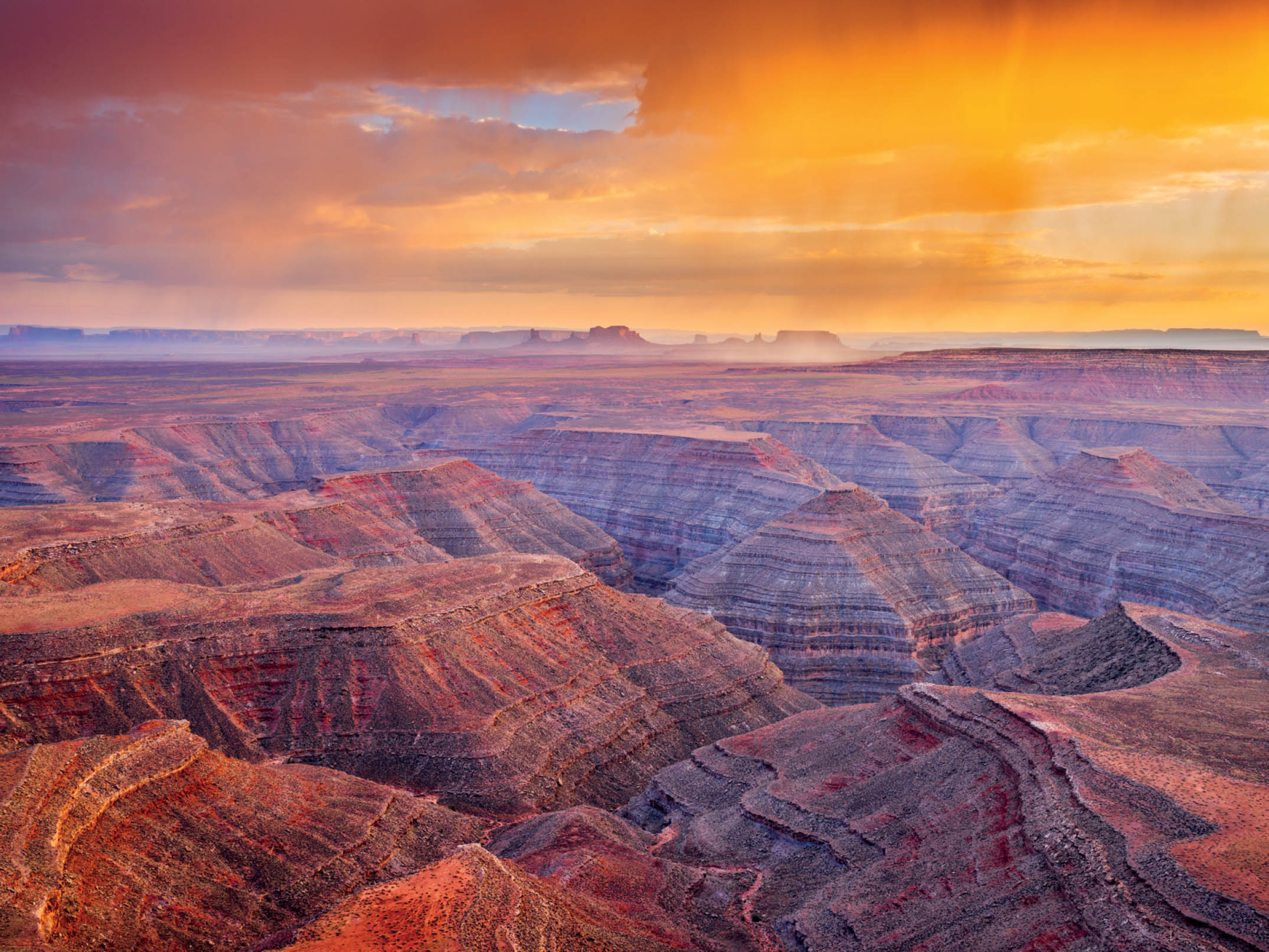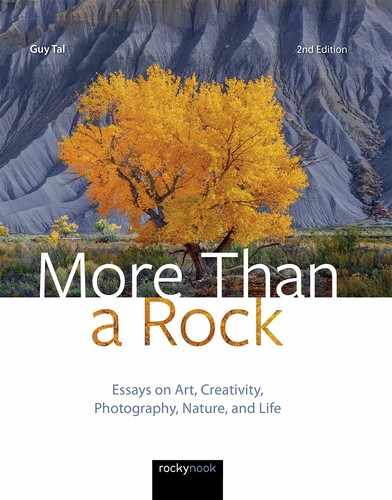5The Things Themselves
The artist is a receptacle for the emotions that come from all over the place: from the sky, from the earth, from a scrap of paper, from a passing shape, from a spider’s web.
—Pablo Picasso
As I made my way home after teaching a workshop in Colorado, I headed south into the high peaks of the San Juan Mountains, stopping on occasion to admire the spectacular scenery. My plan, if it could be called that, was to set up camp in the first place that seemed welcoming and secluded, and to spend a couple of days writing and photographing. Alas, such a place did not present itself. Awed as I was by the majestic views, they felt alien to me. Lofty peaks and abundant woods, verdant and fragrant, looked and felt and smelled wonderful, but to me the call of the sandstone desert beyond was stronger and I kept driving. Beautiful images were to be had, but I wanted more than just beauty and more than just images: I wanted the comfort of open, desolate places; I wanted naked rocks and shrubs and landmarks whose names I knew, and whose stories—at least some of them—were familiar to me.
I ended up on a high desert mesa, surveying before me layers of rock and earth, from the crumbling slopes of the Chinle Formation, through the deep crimson cliffs of the Wingate Layer, and up to the sensuous rounded domes of the Navajo Sandstone, among others. The entire span of the Jurassic period stretched before my eyes—60 million years of some of the most dramatic geography, climate, and life in the history of the planet. At a time when these sculpted rocks were giant dunes—the largest sand desert ever to exist on Earth—dinosaurs walked along their edges and by the shores of the shallow sea whose former floor, lifted almost a vertical mile from its former elevation, today is arid and colorful badlands.
Rabbitbrush, snakeweed, and sunflowers in profuse bloom were everywhere—harbingers of autumn. In the twilight, small bats fluttered about as the low sun ignited the pregnant clouds of distant monsoon rainstorms in vibrant purple and gold. The air was rich with the scents of pine, juniper, sage, and petrichor. This is home to me, as comfortable and familiar as the inside of my own house.
I photographed in a metered rhythm, fitting with the slow unfolding of quiet drama before me, a frame at a time, closing my eyes on occasion to inhale the distinctive air of the high desert and to savor its silence. As darkness set, the familiar call of a Great Horned Owl and a slight breeze in the junipers lulled me to sleep.

I believe that one’s art cannot be fully appreciated only by its final products, no matter how impressive or pleasing they may seem, to an observer lacking deeper insight into the mind and motivations of the artist. In that, my opinion is in opposition to what some call formalism—the belief that works of art should be self-contained and require no further knowledge (e.g., of their provenance or the biographies of their authors) to understand fully.
My own relationships with my subjects, and in a lesser way my relationship with the medium of photography, are among the things that make my photographs more meaningful to me, by virtue of making my life experiences richer and more personally significant. Try as I might, I cannot treat my experiences and my art as distinct and separate things. I believe that the same is true for viewers of art, and not just for artists—the more viewers know about what the work means to its creator, the more meaningful it is likely to become to them, too.
Vincent van Gogh died having never achieved recognition for his work nor any indication of his posthumous celebrity. He pursued his art not for financial gain but because, in his words, “The feeling for the things themselves, for reality, is more important than the feeling for pictures.” Similarly, Edward Weston, who struggled financially for most of his career but nonetheless pursued his calling oblivious to such mundane considerations, proclaimed, “Recording unfelt facts, acquired by rule, results in sterile inventory. To see the Thing Itself is essential . . .” Paul Strand, not only a pioneer of what we now term “fine art photography,” but also one of the first to deserve the distinction of being a humanitarian photographer and a documentary filmmaker, made this similar observation, “Look at the things around you, the immediate world around you. If you are alive, it will mean something to you, and if you care enough about photography, and if you know how to use it, you will want to photograph that meaningness.”
My favorite artists are those who seek significance in their work—a significance that comes from familiarity and fascination—from having a personally meaningful relationship with their subjects and medium, rather than just using them to produce records of superficial impressions and objective qualities. Robert Adams put it poignantly, writing, “If a view of geography does not imply something more enduring than a specific piece of terrain, then the picture will hold us only briefly; we will probably prefer the place itself, which we can smell and feel and hear as well as see—though we are also likely to come away from the actual scene hoping somewhere to find it in art. This is because geography by itself is difficult to value accurately—what we hope for from the artist is help in discovering the significance of a place.” (However, I think that a place may have not just one significance, but as many significances as the number of people who come in contact with it, and sometimes more.)
To be sure, I am tired of the rampant self-promotion in photography. I am disappointed with the pervasive copycat culture that, for many, substitutes for art. Portrayals of places and subjects with which the artist has no deeper intimate connection may well be beautiful, even astoundingly so, but when appreciated as art, these images rarely amount to more than just distraction, decoration, or entertainment. If anything, I believe that such impressions amount to a lack of understanding of what art is beyond aesthetics, or rather what it can be, if so practiced—a life-enriching, courage-giving, meaningful exploration of, and interaction with, one’s world, both within and without; a liberator of the noble, inspired, singular spirit that is within each of us and that is often muted or suppressed by repetition of safe formulas.
I hold the purpose of art to be, as described by Pablo Picasso, “washing the dust of daily life off our souls”; or, as expressed by composer Robert Schumann, “To send light into the darkness of men’s hearts. . . .”
I am equally tired of the delusions of importance that plague so many artists of our day. All art and all people are ultimately forgotten. Civilizations fall; species come and go; planets and stars and galaxies disintegrate. Art may endure a bit longer than its creators, but nothing is forever. The greatest power of art—both to artists and to viewers—is the power of affecting the present: the power of life encountering and seeking to understand something about the world and about itself. Art rewards not because it, or anything else we do, “matters” in the long run, but because it matters right then and there when we engage in it.
